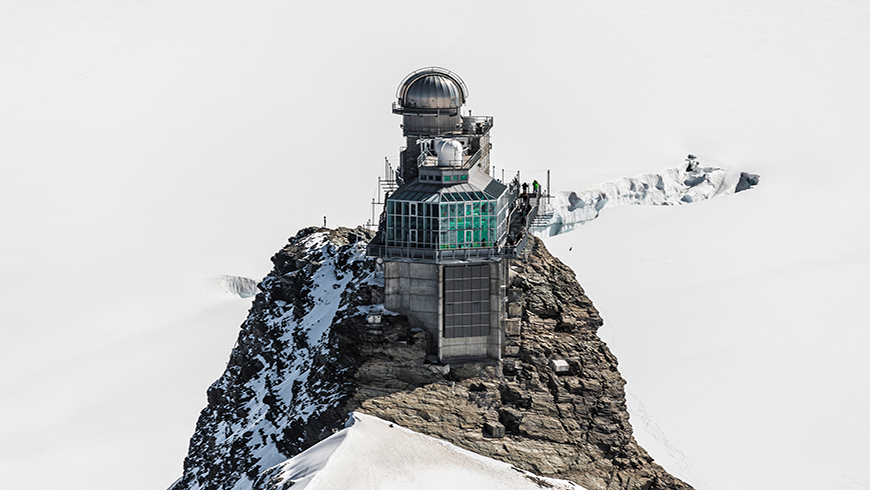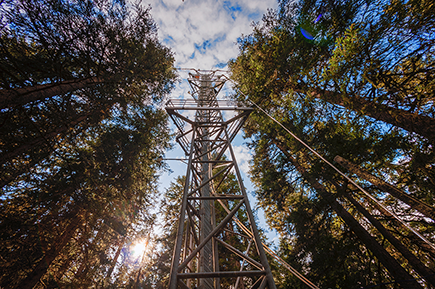Better understanding the global carbon cycle
Network records Europe's greenhouse gas emissions

Half of the carbon emissions released to the atmosphere by fossil fuel use are re-captured by the ocean and land ecosystems. However, we still have many open questions. A recent article in The Bulletin of American Meteorological Society (BAMS) describes for the first time the structure and functioning of the Integrated Carbon Observation System (ICOS) Research Infrastructure.
What is the exact size, nature and stabilities of so-called ocean and land carbon sinks? How will they be affected by climate change? How do these sinks operate in detail, do they continue in the future? How do potential changes affect the atmospheric greenhouse gas concentrations? Answers to these questions are vital information for societies that must decide on pathways to climate neutrality.
"We have the tools to measure these greenhouse gas fluxes. Some of us measure them since decades. And only with such long-term, harmonised time series can we detect and understand the response of the biosphere to slow changes in climate”, says Nina Buchmann, Professor of Grassland Sciences at ETH Zurich, Head of ICOS Switzerland and co-author of the article.
High quality greenhouse gas measurements throughout Europe

ICOS was designed as the European in situ observation and information system to support science and society in their efforts to mitigate climate change. It produces standardized and open data, currently from over 140 measurement stations across 13 European countries. Switzerland contributes with two stations to the network: Jungfraujoch and Davos, both of which are unique in terms of station history, location, and integration into national and international research programs.
For Empa researcher Martin Steinbacher, Principal Operator of the ICOS-relevant greenhouse gas observations at the Jungfraujoch, Chairman of the "ICOS Atmosphere Monitoring Station Assembly" and also co-author of the study, "long-term observations of the variability and trend of greenhouse gas concentrations in the atmosphere, as Empa has been conducting for many years at the Jungfraujoch, are an important piece of the puzzle for greenhouse gas budgets and the carbon cycle. Since only about 50 percent of emissions ultimately remain in the atmosphere, it is crucial to understand the interactions between the atmosphere, ecosystems and oceans." As part of ICOS, atmospheric scientists are working together with ocean experts and ecologists to better paint the overall picture of greenhouse gas cycles. Steinbacher: "The backbone is the coordinated and harmonized monitoring networks across Europe, which have brought the quality and compatibility of observations to a new level."
The ICOS stations observe greenhouse gases in the atmosphere and carbon and greenhouse gas fluxes between the atmosphere, the land surface, and the oceans. The network covers the European continent from Scandinavia to the Spanish peninsula, and from the British islands to Hungary and Czech Republic. The adjacent oceans are covered by ship lines and research vessels operating on the area. Switzerland, with its exceptional geographic location in the central part of the Alps, is an outstanding node within the ICOS network.
Major scientific questions and a glimpse to the future
The article lifts a number of particularly important scientific questions in the field. Due to the growing urgency of climate change, many of these questions relate to policy frameworks such as the Paris Agreement or to the UN Sustainable Development goals. For example, ICOS is involved in providing important basic information to an envisaged EU monitoring and verification support system for greenhouse gas emissions. In this context, radiocarbon methodology is used in quantifying the emissions from fossil fuel burning, as carbon dioxide from fossil fuel sources is void of the radioactive carbon isotope, 14C.
Further research is needed on lateral carbon fluxes from land into oceans, which can currently only be quantified with large uncertainty. Indeed, while ICOS has taken some initial steps to build capacities to quantify also these fluxes, a lot remains to be done yet.
Further, the authors state that more accurate observations are needed in urban areas, since these densely populated areas are fossil fuel emission hotspots, and constantly growing. The success in emission reductions will be first visible there. ICOS is responding to this challenge by kicking off a new EU project “ICOS Cities – Pilot Applications in Urban Landscapes”. Two Swiss cities, Zurich and Basel, are part of the ICOS Cities project, with ICOS Switzerland partners from Empa and the University of Basel. An urban station in Basel will soon complement the Swiss stations within ICOS.
“With ICOS Cities, we aim to test different observation methods, by designing and building urban pilot observatories. We want to test and showcase different tools and services to process and analyse these observations, and do it all in a way that responds to the needs of the cities and supports them in realising their climate action plans,” tells Werner Kutsch, Director General of ICOS, and the coordinator of the project.
On a larger scale, the article mentions the compilation of a European carbon and greenhouse gas budget, which until now has only been possible with a considerable one-time effort. Soon, it could be produced annually, at high spatial resolution and with reduced uncertainty. This type of product would clearly benefit political actors to decide on the most feasible climate actions, like it was recently done at the Climate Conference COP26 in Glasgow.
In conclusion, there are several urgently needed developments in the field of carbon science: how to detect climate change effects on the terrestrial and ocean sinks, how to best support the verification of national and local GHG inventories, and how to validate the efficacy of mitigation actions.
The ICOS article is published in The Bulletin of American Meteorological Society (BAMS).
ICOS Switzerland
Dr. Martin Steinbacher
Air Pollution / Environmental Technology, Empa
Phone +41 58 765 40 48
Katri Ahlgren
Head of Communications, ICOS
Phone +358 40 350 25 57
-
Share
